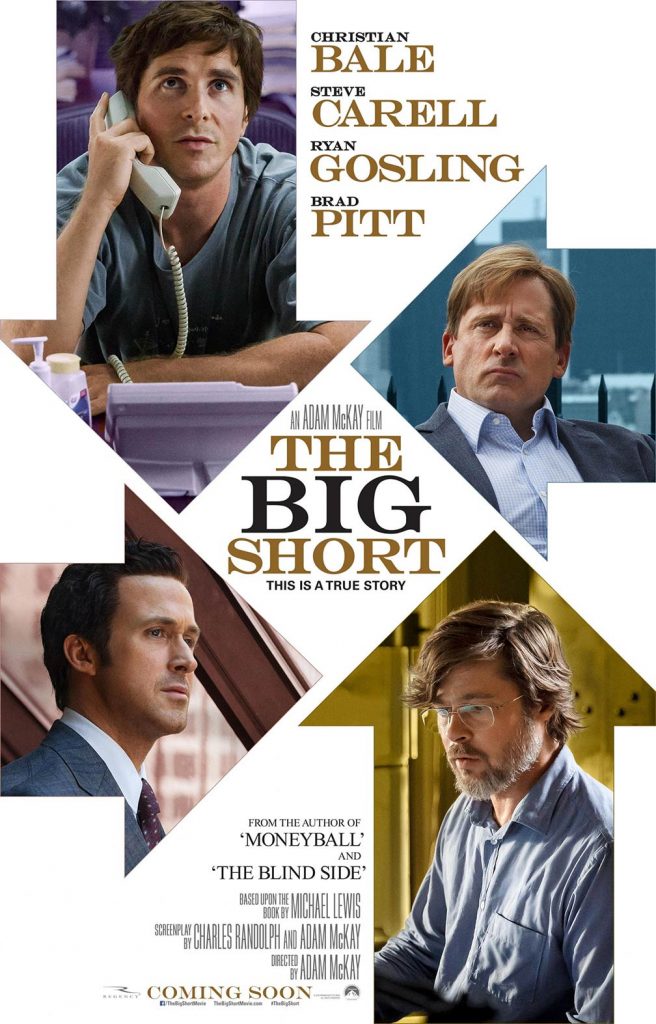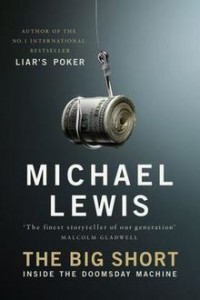“The thought-provoking film is a timely reminder of the lessons from a financial crisis which are too quickly forgotten.”
~ Patrick Durkin, Sydney Morning Herald
Hollywood Tells the Story of the Lie That Crashed the Economy

The Big Short theatrical release
poster, source: Wikipedia.org
Hollywood’s big screen version of The Big Short, based on Michael Lewis’s best-selling book on the financial crash, was released on DVD in March of 2016, following a successful run in theaters. Now six years after the 2010 release of the book, which detailed the story of a handful of stock market contrarians who saw that something was rotten on Wall Street, the message remains relevant as well as entertaining.
The Big Short opens with narration by Ryan Gosling’s character (named Jared Venet in the movie, based somewhat loosely on Deustche Bank salesperson Greg Lippmann) introducing The Big Short as a story about “the giant lie at the heart of the economy.”
What was the giant lie? The fact that the post-9/11, post-tech-crash recovery was a doomed-to-fail boom cycle fueled by consumer spending based on an economic illusion… a huge housing bubble that only a few contrarians could see. As one character in the film asserts matter-of-factly, “No one can see a bubble; that’s what makes it a bubble.”

Image attribution: By Source, Fair use, Wikipedia.org
Director Adam McKay took on a seemingly impossible task: to adapt a complex financial story for box office profits while both entertaining and educating a broad audience of non-economist movie-goers. As Ryan Gosling told Vulture.com, “The film’s point of view is that the language of high finance feels alienating because it’s designed to divide you, to make you feel like you can’t understand it, so that you won’t ask too many questions. And this was like, ‘Let’s pull the curtain back on that whole machine.’”
To pull back the curtain, McKay often breaks the sacred “fourth wall” of cinema with scenes and narration in which characters (and real-life celebrities) speak directly to the viewer. Terms such as mortgage-backed securities, CDOs (collateralized debt obligations), synthetic CDOs and credit default swaps (the financial instrument created to bet against the housing market) are explained in layman’s terms:
- Playing up on the “bubble” theme in a tongue-in-cheek reference to her role in The Wolf of Wall Street, Actress Margot Robbie explains why subprime mortgages are, well, subprime (she uses more colorful language) while sipping champagne in a bubble bath.
- Renown chef Anthony Bourdain describes CDOs by describing how 3-day old fish is repackaged and sold as something “new” in the fish stew special of the day.
- Pop star Selena Gomez partners with economist Richard H. Thaler at a gambling table in Vegas to explain how synthetic CDOs use leverage to place bets upon bets, thereby exponentially expanding the dollars put at risk by the securitization of mortgages.
Meanwhile, the four stars of the film – Ryan Gosling, Brad Pitt, Steve Carrell and Christian Bale (nominated for an Academy Award for his portrayal of Michael Burry) – carry the plot forward with flawless performances.
Particularly compelling is Christian Bale’s portrayal of Dr. Michael Burry, a research-obsessed neurologist-in-training turned money manager who predicted exactly how, why, why, and when the housing market would unravel. Meticulously based on the real-life Burry, down to the details of his glass eye, his discomfort with direct discussions, and his tendency to play drums relieve stress, Dr. Burry was perhaps the first to see the crash coming.
A host of engaging supporting actors help to detail the financial absurdities of the day:
- Melissa Leo has a short but memorable part as a rating agency manager who defensively dismisses concerns that mortgage bonds are failing, only to then confess, “If we don’t give (the banks) the AAA ratings, they’ll go to Moody’s down the street!”
- An ever-cheerful Florida real-estate agent tries to explain away the growing number of for-sale signs by admitting that “the market’s in an itsy bitsy little chasm right now.”
- Young “garage hedge fund” founders (played by John Magaro and Finn Wittrock) embarrass themselves repeatedly, but finally, succeed in their attempts to create a winning fund.
Five Lessons to Take Away from The Big Short
The Big Short is an eye-opening story that brings with its warnings we would be wise to heed. It also succeeds in bringing an important, complex financial topic to the big screen. Here are five lessons that we should take away from the subprime tale of woe:
- Leverage can hurt. Increasingly, financial corporations use leverage to multiply their potential profits, but the leverage can create tremendous pain in the markets when conditions are unfavorable. The same lesson also applies to leverage we might personally use in real estate or a brokerage account; leverage can accentuate the losses as well as the gains. But when leverage is wielded by the largest banks and institutions using derivatives, CDOs (collateralized debt obligations) and other complex securities, the result can be devastating.
- A weak chain link can affect almost every aspect of the economy. Different aspects of the economy – from banking, stocks, and rating agencies to the housing market and mortgages bonds – are tightly twisted. What happens in one sector affects another.
- Market optimism won’t insure against a crash. A fiscal policy built on never-ending appreciation and expansion can bring the economy on thin ice. Loosening of credit standards and lending requirements can create extra cash in the economy, but those practices also create bubbles waiting to burst. And just because a majority of investors, money managers, financial analysts and journalists don’t see a crash coming doesn’t mean there isn’t one around the corner.
- Contrary to Gordon Gecko’s proclamation in another Wall Street movie, greed is not good. Every corner of the finance world – from borrowers to brokerages to rating agencies and government officials – was incentivized in some way to hide the cracks in the foundation of the economic system, even as it was crumbling. We should not rely on banking and Wall Street insiders to care more about the stability of the economy than their own bonus checks.
- Investors should take care to protect themselves from risk. Too often, everyday investors seem to pay the price for the mistakes made by financial corporations as well as government regulators (and de-regulators). No matter how “sure” an investment seems, there is always a need for savings. Housing markets and stock markets rise and fall. A portion of every investor’s portfolio should be in something that grows without fail, slowly and safely, regardless o the economic climate.
The Short Scoop On The Big Short
The movie is entertaining and quite humorous at times, but it never loses sight of the story it is telling. Even as these outsiders succeeded in winning huge bets against the housing market, there are no save-the-day heroes or happy endings. Like an economic version of The Titanic, an air of tragedy and sadness pervades as the financial ship goes down, just as we know it will.
Nominated for Best Picture and Best Supporting Actor Oscars and garnering rave reviews, The Big Short is a big hit. Much more than mere entertainment, it unravels some of the mystery behind why so many homeowners, investors, business owners and employees took such a big hit when the subprime debacle crashed the economy in 2008.
Is it worth seeing? Yes, provided that its R rating (for strong language and glimpses of strip club nudity) doesn’t eliminate the movie from your viewing choices. Whether you agree or disagree with its economic analysis, it is an entertaining and thought-provoking movie.
The Big Short was released on DVD March 15, 2016, and is available through Netflix and anywhere that DVDs are rented or sold. See the film trailer on YouTube:
https://www.youtube.com/watch?v=5Zhy1NQf2NM
Where is Your Money Safe From Wall Street Excesses and Market Swings?
When a life insurance policy is issued, it is the insurance company’s responsibility to make sure that the money will be there to provide benefits and access to cash value, whether the money is needed in one year or 100 years after the policy is issued. This is a responsibility that mutual insurance companies have always taken very seriously. Unlike the stock and housing markets, some things are guaranteed.
Mutual life insurance companies are owned by the policyholders and have no pressure to please shareholders with impressive quarterly reports. On the contrary, life insurance companies have paid not only benefits to beneficiaries but also non-guaranteed dividends for over 150 years. Contact us for further information on how to save safely!
